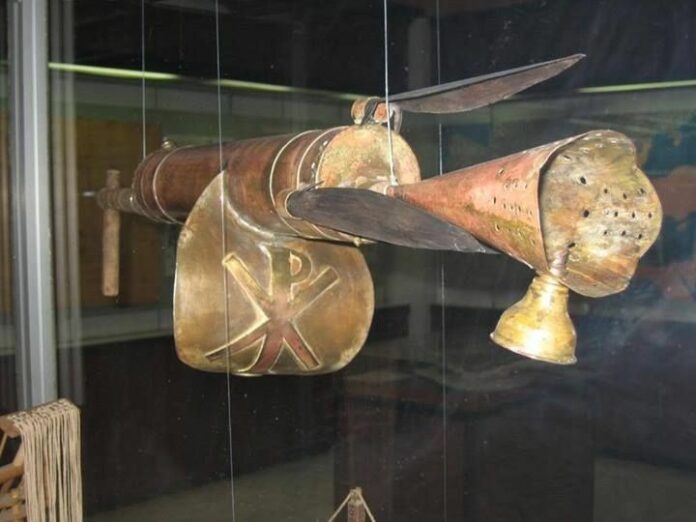The fiery legacy of Kallinikos: The Deadly Byzantine Weapon Known as Greek Fire

Origins of Greek Fire

The annals of military history are replete with weapons that have changed the course of wars, but few have been as mysterious and terrifying as the Greek Fire. For centuries, this incendiary weapon of the Byzantine Empire instilled dread in the hearts of its enemies and played a pivotal role in the defense of Constantinople. Greek Fire, known as “Υγρό Πυρ” (Ygro Pyr) or “Liquid Fire” in Byzantine texts, was primarily used by the Byzantines, especially during naval warfare. Its first recorded use was by the Byzantines in 678 AD during the Arab-Byzantine Wars, where the Arabs, attempting to lay siege to Constantinople, found themselves under assault from a flame that water could not douse, turning the tides of the battle.
The exact origins of Greek Fire remain shrouded in mystery, but many historians believe it was developed in the 7th century by a Christian Greek architect and chemist named Kallinikos of Heliopolis. It’s said that Kallinikos fled from the Arab conquest of Syria to the Byzantine capital, bringing the secret of the fearsome weapon with him.
Mechanics of Greek Fire
What made Greek Fire especially formidable was its unique deployment method. The Byzantines used a tube or siphon, not unlike a flamethrower, to spray the liquid fire onto enemy ships or personnel. These tubes, known as “siphonophorai,” could be mounted on ships or fortifications. When lit, the concoction would ignite, casting a terrifying wall of fire towards the target. The fact that the fire clung to surfaces and was notoriously difficult to extinguish (water was said to exacerbate it) only amplified its psychological and physical impact.
Secret Composition

The precise ingredients and process of making Greek Fire remain a subject of debate and speculation. What’s clear is that it was a petroleum-based mixture, likely involving crude oil, pitch, or naphtha. Some theories suggest the inclusion of sulfur, resin, lime, or even certain organic components like animal fats or oils. The Byzantines went to great lengths to keep the formula a state secret, with the production closely guarded and centralized. This secrecy is why, despite numerous attempts by enemies and allies alike, the exact replication of Greek Fire was never achieved.
Legacy and Decline

The Byzantines’ mastery of Greek Fire helped repel several sieges on Constantinople and ensured naval dominance for the empire in the Mediterranean for many years. However, its use started to decline by the 13th century, possibly due to the loss of the territories that supplied its ingredients or perhaps because of the emergence of alternative military technologies.
Today, Greek Fire stands as a symbol of Byzantine ingenuity and resilience. Its aura of mystery and the visual spectacle it must have created in naval battles make it one of the most fascinating weapons in ancient warfare. While the mysteries of Greek Fire may never be fully unraveled, its legacy in the annals of military innovation remains undeniable. Serving as a testament to the scientific and military prowess of the Byzantine Empire, Greek Fire remains a beacon of ancient ingenuity and a vivid reminder of the lengths civilizations will go to defend their territories and way of life.
Video
News
The Hanging Temple: China’s 1,500-Year-Old Cliffside Marvel of Faith and Engineering
The Hanging Temple: China’s 1,500-Year-Old Cliffside Marvel of Faith and Engineering Perched precariously on the cliffs of Mount Heng in Shanxi Province, China, the Hanging Temple, also known as Xuankong Temple, Hengshan Hanging Temple, or Hanging Monastery, is an architectural…
The Willendorf Venus: A 30,000-Year-Old Masterpiece Reveals Astonishing Secrets
The Willendorf Venus: A 30,000-Year-Old Masterpiece Reveals Astonishing Secrets The “Willendorf Venus” stands as one of the most revered archaeological treasures from the Upper Paleolithic era. Discovered in 1908 by scientist Johann Veran near Willendorf, Austria, this small yet profound…
Unveiling the Maya: Hallucinogens and Rituals Beneath the Yucatán Ball Courts
Unveiling the Maya: Hallucinogens and Rituals Beneath the Yucatán Ball Courts New archaeological research has uncovered intriguing insights into the ritual practices of the ancient Maya civilization. The focus of this study is a ceremonial offering found beneath the sediment…
Uncovering the Oldest Agricultural Machine: The Threshing Sledge’s Neolithic Origins
Uncovering the Oldest Agricultural Machine: The Threshing Sledge’s Neolithic Origins The history of agricultural innovation is a fascinating journey that spans thousands of years, and one of the earliest known agricultural machines is the threshing sledge. Recently, a groundbreaking study…
Nara’s Ancient Sword: A 1,600-Year-Old Protector Against Evil Spirits
Nara’s Ancient Sword: A 1,600-Year-Old Protector Against Evil Spirits In a remarkable discovery that has captured the attention of archaeologists and historians alike, a 7.5-foot-long iron sword was unearthed from a 1,600-year-old burial mound in Nara, Japan. This oversized weapon,…
The Inflatable Plane, Dropped Behind the Lines for Downed Pilots
Experimental The Inflatable Plane, Dropped Behind the Lines for Downed Pilots The Inflatoplane from Goodyear was an unconventional aircraft developed by the Goodyear Aircraft Company, a branch of the renowned Goodyear Tire and Rubber Company, also famed for the Goodyear…
End of content
No more pages to load











